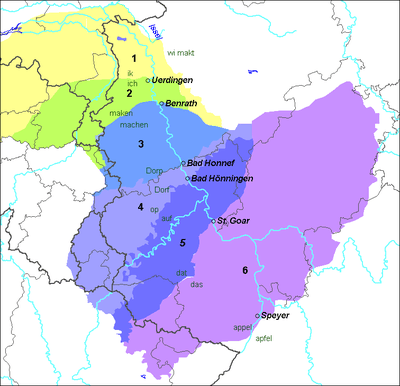Rhenish fan
The subdivision of West Central German into a series of dialects, according to the differing extent of the High German consonant shift, is particularly pronounced. It known as the Rhenish fan (German: Rheinischer Fächer, Dutch: Rijnlandse waaier) because on the map of dialect boundaries, the lines form a fan shape.[2] Here, no fewer than eight isoglosses, named after places on the Rhine river, run roughly West to East. They partially merge into a simpler system of boundaries in East Central German. The table on the right lists the isoglosses (bold) and the main resulting dialects (italics), arranged from north to south.
| Dialects and isoglosses of the Rhenish fan (Arranged from north to south: dialects in dark fields, isoglosses in light fields)[1] | ||
| Isogloss | North | South |
|---|---|---|
| Low German | ||
| Unity plural line | wi maakt | wi maken |
| Dutch | ||
| Uerdingen line (Uerdingen) | ik | ich |
| Limburgish | ||
| Benrath line (Boundary: Low German — Central German) |
maken | machen |
| Ripuarian Franconian (Cologne, Bonn, Aachen) | ||
| Bad Honnef line (State border NRW–RP) (Eifel-Schranke) |
Dorp | Dorf |
| West Mosel Franconian (Luxemburgish, Trier) | ||
| Linz line (Linz am Rhein) | tussen | zwischen |
| Bad Hönningen line | op | auf |
| East Mosel Franconian (Koblenz, Saarland) | ||
| Boppard line (Boppard) | Korf | Korb |
| Sankt Goar line (Sankt Goar) (Hunsrück-Schranke) |
dat | das |
| Rhenish Franconian (Pfälzisch, Frankfurt) | ||
| Speyer line (River Main line) (Boundary: Central German — Upper German) |
Appel | Apfel |
| Upper German | ||
 The Rhenish fan: 1 Dutch (West Low Franconian), 2 Limburgian (East Low Franconian), 3 Ripuarian Franconian, 4 & 5 Mosel Franconian, 6 Rhenish Franconian | ||
References
- The table of isoglosses is adapted from Rheinischer Fächer on the German Wikipedia.
- Rheinischer Fächer – Karte des Landschaftsverband Rheinland Archived February 15, 2009, at the Wayback Machine
This article is issued from Wikipedia. The text is licensed under Creative Commons - Attribution - Sharealike. Additional terms may apply for the media files.